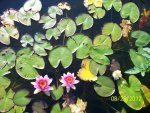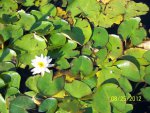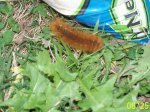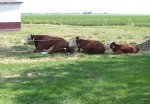Wow, great deal, Sissy! I'll have to check that out, as I'm heading to Menards right now to get the fertilizer and kitty litter at Wal-Mart or Dollar Store.
OK, so what is everyone's opinion. Are the turtles doing the damage or the moths? Does anyone have this type of problem with their lilies? I guess I should be asking someone close by. I'll have to PM the person from Sullivan, Illinois. Anyhow, here is a pic of the lake lily (on the right side of the pic, leaves are more elongated) that I put in last summer. It has never bloomed but I noticed it is hardly touched by the cuts. So .... now I'm wondering if all the damage is from some type of bug instead of the turtles.

This is what all my lily leaves look like in my ponds. It looks bad, but they are still blooming, even though I've given them the wrong type of fertilizer. I'm sure there would be larger and MORE blooms with the right stuff, which I will remedy today!

Does anyone else have this leaf damage? Last year, with Aris (he was maybe 4" and my larger turtle is about 6" keep in mind) there was no leaf damage that I remember. This year, none until the last 2-3 weeks. The turtles have been in there since early spring. I'm trying to give the turtles the benefit of the doubt, and don't have any plan for removing them from my pond, as others will make it there on their own, but want to know for sure if they are doing the damage, or if I have some type of parasite or bug that is doing it.
This is what I found on the internet about the China Mark Moth:
ECOLOGY: The larva is a fascinating creatures as it commences its life feeding on water weed such as
water lilies (from which the scientific name is derived) and the Common Pond Weed (
Potamogeton). It enters the leaf feeding from within it and obtaining oxygen from the air spaces within the plant. Later, it emerges to feed on the outside and constructs a distinctive flat case of the weed. This is a particularly unusual lepidopteran in that the larvae live underwater. It cuts small ovals of leaves and binds them together with silk threads to form a flat "pouch" within which it lives. This is dragged around behind it somewhat like a caddis fly. Within this a large air bubble develops and as the larva feeds so the head can be seen to be surrounded in air (a silvery appearance). Some other species are known to use gills and do not have the bubble of air. It hibernates during the winter and resumes feeding in the spring, eventually forming a cocoon within which to pupate near to the food plant. The adult emerges in the summer but moves away from the watervery little, living only a few days. After mating it lays eggs on the underside of water plants by bending the abdomen around the edge. The adult flies between early and late summer but lives for just a few days.







